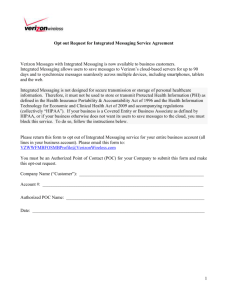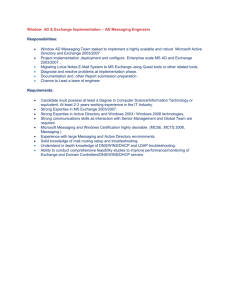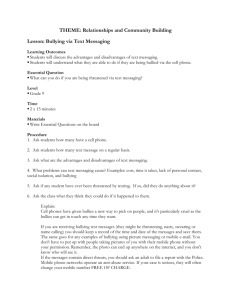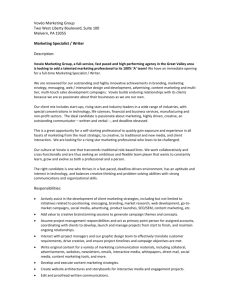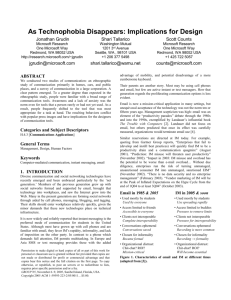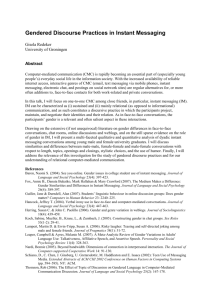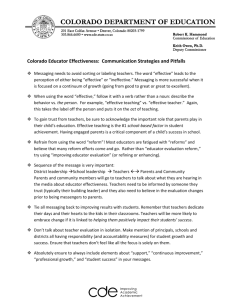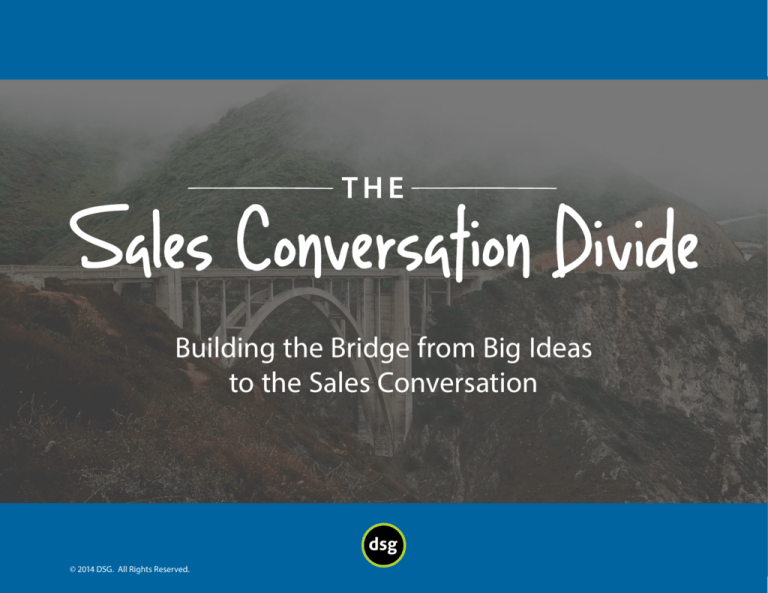
Building the Bridge from Big Ideas
to the Sales Conversation
1 2014©DSG.
©
2014All
DSG
Rights Reserved.
What is the Sales Conversation Divide?
You have everything in place... the strategy for growth, the branding, marketing messaging, and campaigns. There’s just one problem. How are
you going to make it all reality? How will you connect your big ideas with what your sales team is doing in the field? Whether you are trying to
get into a new account or reposition yourself in an existing account, you need to bridge the divide that often exists between strategy and what
sales people actually say, do, and show.
Messaging
Growth
Strategies
What
sales people
actually say
What sales people
actually show
Brand
Strategy
Campaigns
The initial sales conversation really becomes a strategic moment and a great starting point for teams that want to achieve better messaging
alignment. The marketing message has worked; it has created an identity that led to this first sales conversation. Then, how does a company
translate that brand promise into the actual words the sales team uses with customers? That question creates energy within marketing and
product teams around the possibility of consistency in first customer engagement. Sales can become energized as well when the focus is on
the field being equipped with sales-ready content for early stage conversations.
Research shows that sales reps create their own presentations. Without being equipped with the right messaging, sales will take ownership
of generating the messaging. The “State of the Sales Rep” study by Brainshark (2013) shows that, of sales reps who receive content from
marketing, 42% say that marketing “rarely” or “never” makes them part of the development process. Sales reps report that they end
up creating 51% of the content they use on their own.
Sales reps will say something in the sales conversation, and it can be either the right message to differentiate your company or not. The right
message is in line with the vision of the company and how you want to position yourself in the marketplace—including all the competitive
research provided by marketing. But, if the sales and marketing teams don’t work together to establish the right conversation messaging, sales
does their own thing—makes up their own slide decks, tells their own stories, drafts their own whiteboards, and asks their own questions.
2
© 2014 DSG
Consequences of Not Bridging the Sales Conversation Divide
Missed opportunities
for growth
Lack of differentiation
Inconsistency
the “same old story”
Opportunities are missed when sales stays
focused on legacy products they feel more
comfortable with or sticks with the “same
old story” in customer conversations
When reps start to talk about what
makes your approach unique, the
customer shouldn’t be thinking
“Yeah, you and everyone else...”
The divide can look like a lot of finger pointing. Sales, marketing, and product
teams believe they are delivering, but the reality is that they are not on the same
page and haven’t agreed on a common approach on how we go to market in
an integrated way. I think that kind of misalignment is not uncommon, and it
certainly isn’t healthy for a business.
Dawn McPhail
Sr. Director, Integrated Marketing
3
© 2014 DSG
A geographically diverse sales team
shouldn’t mean sales conversations
are all across the board
What Success Looks Like
Step 1: Align on what Sales Messaging Is and Isn’t
Sales Messaging [seylz mes-uh-jing] noun: The words and visuals for leading meaningful, customer-focused conversations. What sales reps
will actually say and show during an in-person meeting or a virtual conversation. Complete sales messaging includes insights to share, smart
discovery questions to ask, stories to create meaning, and visuals that make the conversation tangible.
The words and visuals for holding a meaningful customer-focused conversation are
the essence of sales messaging which is different from the high-level brand messaging
and product messaging that positions a company’s solutions. There’s so much time
and money spent at the upper portions of the messaging pyramid—on corporate
strategy (where we are placing our bets), marketing strategy (how we go to market),
brand messaging (how we position ourselves in the market), and product messaging
(positioning individual products and services). The missing link is often the sales
message—what to say and how to say it. The sales messaging content is what helps us
balance the information we’re broadcasting to the market with what sales people are
narrowcasting in customer conversations. By the time it gets down to sales messaging
(what we say), everything else is more general, so you’re broadcasting information
about yourselves, versus sales messaging which is the narrowcasting.
It’s narrowly defining and
communicating what you do and how
you can do it in the sales messaging
conversation. Broadcasting and
narrowcasting are very, very different.
Narrowcasting is down at the
3-foot level, so you’re really specific
and having conversations, while
broadcasting brand messaging and
above is more the 30,000 foot level.
So it’s about getting from that 30,000
foot level down to the 3-foot level.
Tanner Mezel,
Principal
4
© 2014 DSG
At the heart, connecting strategy
and branding to sales messaging
ensures compelling conversations
are happening every day with
customers. When messaging brings
together high level strategy and dayto-day customer conversations, your
organization’s big idea for growth or
change turns into real results.
I think the biggest challenge for marketing is
in terms of delivering content and then effectively
enabling a sales organization. As marketers, we’re
great at developing messaging and we’re great at
developing content, but what we often lack is a layer
that can help translate that into something that
is meaningful for a salesperson. So we’re building
things for a market and for a customer, we’re not
necessarily building things with the understanding
of a salesperson and how they learn.
Dawn McPhail
Sr. Director, Integrated Marketing
Step 2: Prioritize Messaging
There is no one-size-fits all approach to sales messaging. It is important to identify the real requirements of the sales team and prioritize the
types of messaging needed to make them successful. This could range from comprehensive to at-a-glance content and tools:
Comprehensive
Enterprise
Story
"At-A-Glance"
Key Plays
Partner
• Key Plays
• Solution – how to position an integrated
solution or solution portfolio
• Industry – how to speak to the unique trends,
pressures, and opportunities within a vertical
• Audience – how to engage key functional roles
(marketing, finance, IT, etc.)
• Partner – how to position a joint solution with
a partner
• Competitive – how to differentiate from named
competitors
• Offerings – how to sell a discreet product or service
© 2014 DSG
Competitive
Offerings
Solution
• Enterprise – how to deliver the “umbrella message”
across products, solution lines, or business units
5
Industry
The Winning Mix for
Adobe needed a way for their reps located across the globe to receive sales messaging
guidance and tools for early stage discovery and positioning conversations. Asseem
Chandra, VP of Product and Industry Marketing for the Digital Marketing division,
supported his organization’s shift to an industry-specific messaging strategy by creating
sales messaging playbooks for the worldwide sales team. The initiative revolved around
the development of playbooks for each prioritized industry vertical, with a focus on telling
the complete, enterprise story spanning the digital marketing product portfolio. Based on
the initial success and momentum around industry playbooks, Aseem’s team transitioned
to solution-level playbooks focused on connecting the dots between customer
requirements and core Adobe solutions.
The playbook structure provides Adobe’s global sales team with practical messaging
guidance throughout the sales conversation process—from preparing to meet a
customer executive through actual delivery of the messages and sharing insight.
Essential tools within each playbook: a visual framework for telling the story on a
whiteboard or via interactive web meeting, trends and insights to establish credibility, talk
tracks by customer audience, and competitor selling guides.
Step 3: Agree on a Common Playbook Structure
To bridge the sales conversation divide, organizations should focus on the what
salespeople need for their next sales conversation.
What’s your structure for building, packaging, and deploying messaging tools?
An approach that’s gained a lot of momentum in recent years is the concept of
a sales playbook. We’re finding playbooks that provide the what to know, what
to do, what to say, and what to show are meeting the needs of sales people and
driving utilization:
What to Know
Providing the knowledge
required to understand the
customer’s world.
•
•
•
•
Sales Strategies
Trends
Audiences
Priorities & Pain Points
What to Do
Guiding the team on actions
to take in the field
•
•
•
•
What to Say
The actual words, stories,
and insight for leading a
conversation
•
•
•
•
Customer Stories
Insights & Provocations
Discovery Questions
Proof Points
Buying Process Map
Discovery
Conversation Plan
Sales Tactics
What to Show
Using visuals to create
dialogue and make your
message memorable
•
•
•
•
Quick Videos
Animated Models
Pictures
Whiteboards
The playbook is a great way to leverage
what we previously provided as static
content. And it is more appealing to our
team in this format. Our salespeople
want this type of interactive content
because it’s more intuitive.
Robbie Traube
VP Industry Strategy
and Sales Marketing
6
© 2014 DSG
Current Alignment Efforts Center on Meetings
“What things have you done to align sales and marketing that have succeeded?”
ACTIVITY
ROLE
Marketing Director
“Have marketing participate 100% in weekly sales meetings
and annual sales revenue summit.”
CMO
“Meetings in-person or via Skype (monthly) bring open issues
to the surface.”
VP of Sales/Marketing
“Annual joint meetings.”
Marketing Director
“Collaboration between sales and marketing in the planning
process.”
Marketing Manager
“Including sales/marketing in each others’ planning cycles.”
VP of Sales
“Marketing is invited to, and actively participates in, sales
team cadence calls.”
VP of Sales
“Invite marketing to customer calls.”
VP of Marketing
“Involve sales in marketing projects at an early stage.”
Director of Marketing
“Joint pipeline reviews.”
Marketing Manager
“Members of each group attend each other’s meetings.”
Marketing Director
“Collaboration on development or marketing collateral.”
Marketing Director
“Marketing people involved in sales work; salespeople
involved in marketing work.”
Sales Director
“Quarterly campaign planning with action items and owners.”
VP of Sales/Marketing
“Weekly meetings to discuss campaigns, materials, and
follow-ups.”
CMO
“Weekly sales/marketing meetings.”
Base: 66 marketing and sales leaders
Source: October 2010 Marketing and Sales Alignment Survey; Forrester Research, Inc.
7
© 2014 DSG
Field Actions for Aligning
Sales & Marketing
Thomas Marks, Sr. Director, SMB Product
Marketing, North America at Concur
Technologies, outlines some steps his team in
marketing has taken to understand sales needs:
•
Ride-alongs with the sales team, where
marketing joins a sales call as an observant
party
•
Call observations are captured so that
marketing can analyze the types of questions
sales is being asked and the difficulties
they face in the sales process. This tunes
marketing in to sales’ needs, leading to the
ability to shape the sales messaging content
and tools.
•
Practice groups that enable marketing to
foster collaboration between field-marketing,
client marketing, and channel marketing
•
Series of meetings designed to connect
marketing with sales as a team that is
collectively responsible for the end-to-end
lifecycle of a prospect—from curiosity all the
way through to becoming a customer—and
making sure the customer experience is the
best it can be
Step 4: Build, Deploy, Sustain
Build
Almost as important as having a messaging playbook to equip the team is the actual
process of creating the tool. By assembling a team of the organization’s top thought
leaders, you gather the best practices and insights that may otherwise only exist within
the heads of your top people.
Extracting best practices and insight from your team can happen in four steps:
1. Assemble the Team – select thought leaders across sales, marketing, and product
2. Facilitate a Collaboration Session – gather a cross-functional team for 1 to 2 days to ideation and debate
around a specific message and the associated tools (focus on a solution, an industry, a “sales play,” etc.)
3. Create a Playbook – build out a playbook based on workshop outputs and focus on organizing content
around 4 areas: What to Know, What to Do, What to Say, What to Show
4. Create videos for each section of the playbook – capture video of your top sales people and thought
leaders sharing insights and demonstrating best practice role plays for each section of the playbook
From a marketing leader’s perspective, I
think the biggest takeaway is the process
for creating the Sales Messaging playbook
and training. Going through that creation
process and training is as important, if not
more important, than the content itself.
The creators and the writers in marketing
often feel very close to their content, but if
you really want to affect the behavior of the
people on the sales team and the product/
service team, it’s really important for
everyone in sales, marketing, and product
to go through the process together.
Jim Karrh - Consulting Principal
Deploy
Where are you reading this brief? On your mobile phone between meetings? On your tablet while waiting in an airport lounge?
As our work becomes more mobile, so must the way we equip our sales teams to have compelling conversations. With
most of your team in the virtual world, you don’t have the luxury of the local branch office where everybody congregates
around the water cooler to share sales stories. For increasingly virtual teams, how do you work with them in a way that ensures consistency in
Sales Messaging delivery and helps sales work faster and smarter?
To successfully deploy the playbook, companies should build the expectation that the playbook is the single source of best practice, sales
conversation content, and practical tools. Deployment and ultimately sales mastery through use of the content comes down to getting it right
in 3 primary areas:
Sales Conversation Training - If a playbook is
to become the single source of best practice, it’s
imperative for the team to be trained around how
to integrate the messaging into conversations.
Long-term use of the messaging is best initiated
by training that allows the team to practice and
plan the real conversations they will have within
opportunities they are working.
8
© 2014 DSG
Interactive, Digital Playbook - A Sales Messaging
Playbook can exist in multiple incarnations—whether it
is accessed through your LMS, an internal portal, via
Salesforce.com, or a web app opened in a browser. To
achieve consistency between the “big idea” for strategic
direction and Sales Messaging, sales teams need a messaging
tool that’s built for where they live—the virtual world. The
most important part is that the playbook becomes a mobile
asset that can be accessed easily and updated frequently.
Sales Leadership Buy-In and
Accountability - The success of a
Sales Messaging Playbook is largely
based on active involvement by sales
leadership. When leaders are held
accountable to coach the field in the
adoption of new messaging, the speed
and results generated dramatically
improve.
Sustain
A simple way that sales and marketing can stay aligned over time is through partnership around the playbook. The playbook
becomes that practical daily use tool for the sales team.
If sales and marketing are both invested in improving it and making it an “evergreen” playbook (where the messaging gets better
over time), that will truly keeps sales and marketing aligned.
One of the things we hear unilaterally across the sales team, is that when they see frequent updates to a playbook, it
really reinforces the feeling of, ‘I’m well prepared. I have the latest, greatest messages and stories.’ Sales teams prefer
frequent updates even to large quarterly releases; they feel they are more informed by last week’s conversations—the
more confident they feel, the more motivated they are to use the playbook tool.
Matt McClendon - President
The best playbooks are informed by the latest insights. Insights from the marketing
team including: what the competition is doing, where the market is going, what the
analysts are saying, and what the research is saying. In parallel, sales is leading sales
conversations, learning from customers, and seeing what competitors are doing.
Harvesting and packaging these insights from both marketing and sales is crucial
to the ongoing usefulness of the playbook and results in a truly “evergreen”
playbook.
Increased alignment should be expected throughout the Sustain phase and will typically
bring marketing and sales into tighter alignment over time. Keep in mind that the
templates and structures will probably need to evolve and this is part of the process of
keeping your strategy, marketing efforts, and sales pursuits in sync. Always be evaluating:
Do we need to add new content? What tools are missing? Does the existing content
need to be improved?
9
© 2014 DSG
The Sales Conversation Aligned
Key to Success
A way we prompt the right level of discussion with sales and marketing
groups is by asking a series of questions. Would the customer be willing
to pay for that initial conversation? Is it truly consultative enough? Is there
enough insight? Are you telling them something that they didn’t know
prior to that meeting that they would be willing to pay for based on the
value of that conversation?
Matt McClendon – President
If your sales team is not delivering the kind of conversation that
customers would pay for, then the Sales Conversation Divide has
not yet been eliminated. Focusing on the initial conversation and the
insight that the customer would be willing to pay for is an excellent
starting point for aligning sales, marketing, and product teams.
I think the key to our success
was having sales and marketing
be equal stakeholders in the
playbook and the messaging.
Contributors:
The program wasn’t conceived
•
Matt McClendon – President, DSG
as a sales initiative or a marketing
•
Tanner Mezel – Principal, DSG
initiative. It was truly a joint
•
Jim Karrh – Consulting Principal, DSG
initiative.
•
Heather Easterday – Consulting Principal, DSG
•
Bruce Scheer – Consulting Principal, DSG
•
Dawn McPhail – Sr. Director, Integrated Marketing, Desire2Learn
•
Thomas Marks – Sr. Director, SMB Product Marketing, NA, Concur Technologies
•
Robbie Traube – VP Industry Strategy and Sales Marketing, Adobe
10
© 2014 DSG
Thomas Marks, Sr. Director,
SMB Product Marketing, NA
Next Steps
Web Meeting with a DSG Consultant - We can
share examples of conversation-ready content and
tools, real playbooks, and relevant stories from
clients who have bridged the sales conversation
divide. Reach out to schedule a web meeting:
info@dsgconsulting.com
Jean
Tanner
1-877-371-2328
Tega
Further Reading - For more B2B
Sales Enablement insights go to:
dsgconsulting.com/insights
@JustAddDSG
DSG Consulting
11
© 2014 DSG.
DSG All Rights Reserved.
Matt

